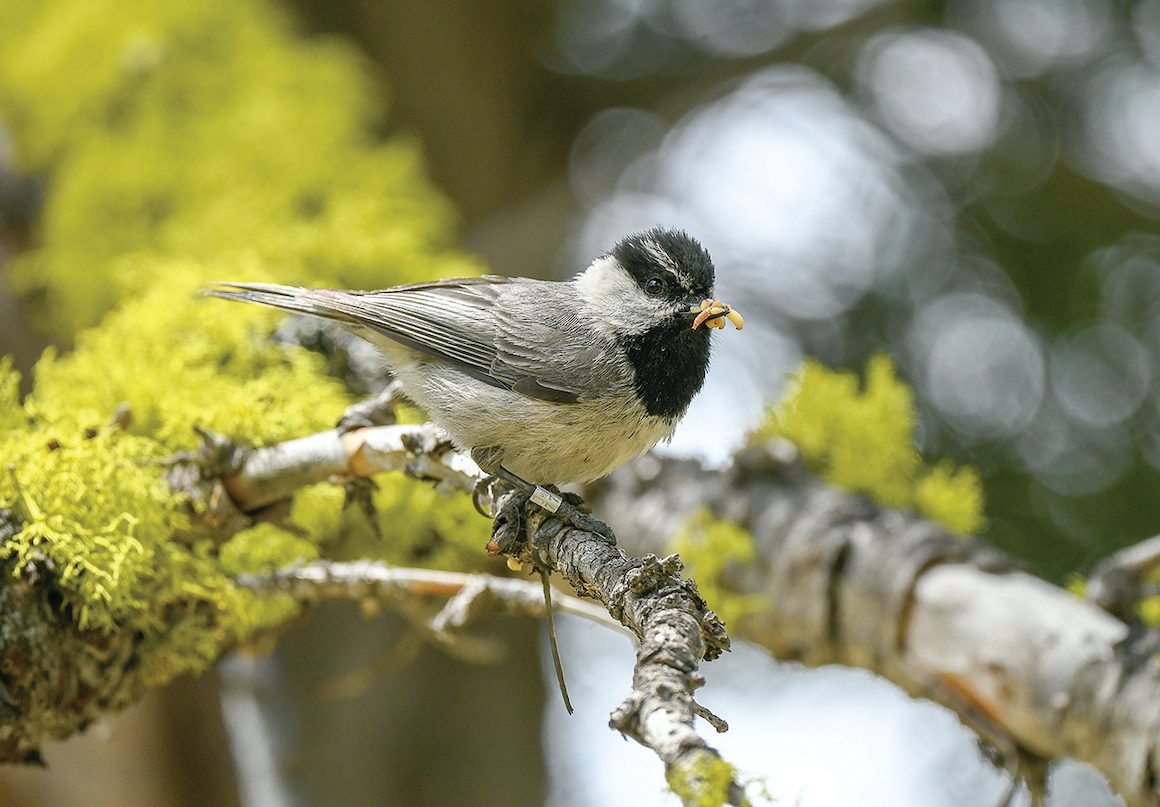
01 Jul AI: Animal Intelligence
What are the smartest beasts and birds in the Tahoe area, why is that a controversial question and what does ‘smart’ even mean, anyway?
If you can read this, you’re probably not a bear.
Tahoe’s largest residents can’t comprehend printed language—as far as we know—but anyone who’s heard recent stories about, say, a mama and her cubs in the Incline Village area figuring out how to open bear-proof boxes to get the food inside knows there’s at least some intelligence flickering between those fuzzy brown ears.

Curious Tahoe black bears in their element, photo by Jesse Bradford
“Bear boxes worked really good for a really long time,” says Raquel Martinez, urban wildlife coordinator with the Nevada Department of Wildlife, “and one of them figured it out.”
Now, she says, a bear box company is retrofitting the units by making the openings narrower to prevent access to everything but humans.
This level of ursine ingenuity is not news to Martinez, who used to work on a bear management team in Yosemite. She talks about the infamous “Snow Creek Bear,” who discovered that canisters impenetrable to big paws are actually quite susceptible to the forces of gravity. The bear would steal canisters, take them to the edge of a cliff and toss them off, then lumber down and eat what was revealed among the shattered remains. Teams enforced a “hard closure” of the area, Martinez says, and once the collared and tagged bear lived out the rest of her life, reports of canister-chucking stopped.
Given that a cub spends the first year of its life following around and learning from its mom, it seems like humanity—or at least hikers in the Yosemite area—lucked out in that the secret of gravity-powered food access apparently died with the Snow Creek Bear. Those cubs in the Incline area, however? They’re likely to remember what they learned from their mother about getting into bear boxes and keep trying to puzzle out how to get past the next iteration of obstacles. If they continue to succeed and have cubs of their own someday, there’s a good chance they’ll pass on the knowledge.
Humans are essentially in a sort of arms race with not just bears, but all manner of creatures, always trying to stay one step ahead of the hungry mouths on the other side of the door.
Animals Being Animals
Unfortunately, as habitat shrinks, climate change forces certain species into new areas and people push ever farther into the wilds, opportunities for beasts and birds to show off the best abilities of their gray matter will continue to present themselves.
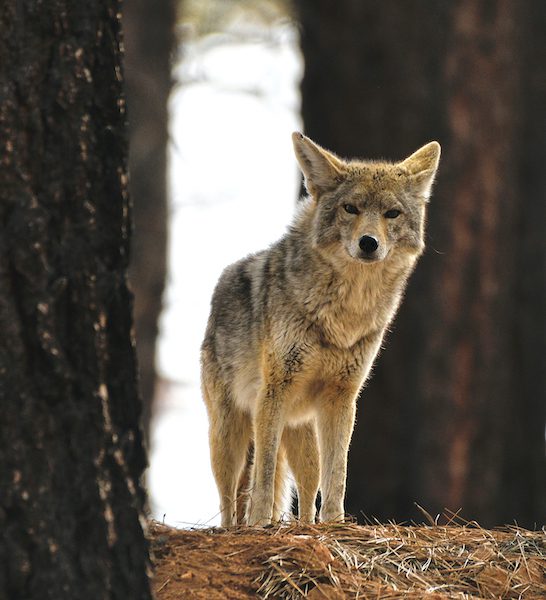
A coyote pictured near the Carson River in Alpine County, photo by Kim Steed
Why is it unfortunate? Wildlife becoming acclimated to human-provided meals is rarely a good thing for either party. Martinez explains that animals that grow accustomed to getting food from human sources remember their meal tickets. This is known as food conditioning, and it can lead to problematically altered behavior, as well as danger if the expected menu isn’t available when the animal thinks it should be. This is not necessarily a hawk realizing it has a captive buffet in the form of birds trapped in the lofty ceiling of a warehouse—as someone recently reported to Martinez—but is more commonly humans giving forest creatures food, from sandwiches to chips to whatever.
“It’s why we talk until we’re blue in the face about why people should not feed animals,” Martinez says, noting that someone may think it’s cute to palm snacks to a coyote up close until it goes for an outstretched hand expecting a treat only to find it empty—but bites down anyway.
“This isn’t your Disneyland moment,” she adds.
That’s part of why she works to help people understand animals and their behavior in the western Nevada region. It’s not just about food.
In the late spring, Martinez and her colleagues are “ridiculously busy” responding to calls from locals who encounter animals being animals—in other words, surviving as best they can—and think there’s a problem. Many of these calls are about babies that seem abandoned if you don’t know that young birds fledge—or skitter around on the ground before they develop enough strength for sustained flight—or how rabbits and deer leave their young tucked into dens so as not to attract predators while they’re out foraging.
By mid-May of this year, Martinez’s region had already fielded about 2,000 calls, whether from homeowners wondering why birds were attacking them (turns out there was a nearby nest, which calmed the “victims” when they realized it wasn’t their personal Alfred Hitchcock scenario) to recent transplants from England encountering the native fauna for the first time and wondering whether what they were seeing was normal.
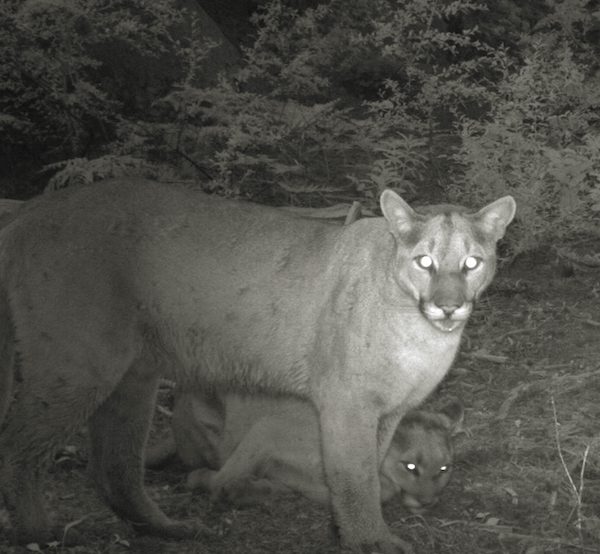
Mountain lions captured on a wildlife camera, photo courtesy National Park Service
Even the proliferation of post-pandemic home offices and cheap security cameras has contributed to the influx of calls. That mountain lion you just saw on your little motion-activated screen? It may have always been passing through your property. It’s just that you see it now because you have eyes on its path.
Of course, the constant desire to find food is always going to be a primary driver of animal-human interactions. Maybe this isn’t a bear problem, or a coyote problem, or a hawk problem, Martinez says. “Maybe it’s, ‘Oh yeah, I’ve been leaving my garbage wide open, and they smell that!’”
“Bears at some point in life got access to human food and garbage,” says Margaret Lord, wildlife education coordinator for the Nevada Department of Wildlife Western Region. “It’s a lot less work to get a million calories from pizza than foraging for 14 hours. Is it smart? Yeah! They figure it out. But it’s not a good thing. Once birds, animals, fish, whatever associate people with food, it comes with some pretty serious consequences. We want them to have their natural instincts to find food, survive, be wild and participate in the natural ecosystems.”
A Mind for Memory
One local animal that seems to be relatively unfazed by humans putting out food are mountain chickadees—aka “cheeseburger birds.” Yes, these predominantly gray birds with badger-like black-and-white-striped faces will scoop up seeds scattered for them or stocked in feeders, but they don’t eat much of it. Instead, they hide it.
“They don’t stop,” says Vladimir Pravosudov, professor of biology at University of Nevada, Reno. He explains that chickadees will create thousands of little food stores in anticipation of the coming winter: “They’re like caching machines.”
Pravosudov says studies show that chickadees in captivity will even cache non-food items, revealing that the behavior is impulsive. In that regard, he notes, “People are just kind of there. People feed them, but it does not have much of an impact at all.”
These chickadees have been in the scientific spotlight recently thanks to the publication of a paper Pravosudov co-authored titled “Genes and gene networks underlying spatial cognition in food-caching chickadees.” The paper explains the team’s dive into understanding the birds’ extraordinary spatial memory, identifying a genetic basis, developmental pathways and more.
Born in 1960, Pravosudov began studying caching—the term for how animals hide food for future use—as an undergraduate student in 1978. In his late teens, he found himself wondering how little birds known as willow tits were able to survive in arctic-type environments, so he decided to make that his academic pursuit.
In 1991, Pravosudov came to the United States (“the Soviet Union was collapsing, everything was horrible,” he says) as a grad student. He found an advisor in the field of cognition at UC Davis and began working among chickadees in the Sierra Nevada in 1999. He eventually landed a faculty position at UNR and moved to the Tahoe area in 2005.
Tahoe’s mountain chickadees, he explains, are similar to the willow tits and Siberian tits that first sparked his interest in caching in his homeland. Here, the birds sing “cheeseburger-cheeseburger” in the summer, but call “chickadee-dee-dee” in the winter. The colder months also signify another shift: from finding food that’s abundant in the warm season to dropping by a snow-dusted Jeffrey or lodgepole pine to grab a cached meal when everything is white.
Throughout December, January, February and the surrounding harsh weeks of late fall and early spring, the wild chickadees’ survival depends less on how much they cached, Pravosudov explains, and more on whether they can actually find what they hid months prior. Every seed stuck behind a patch of lichens or beneath a bit of bark helps.
“Finding the food is based on their memory, which is an amazing adaptation,” he says, though he cautions against labeling the birds as geniuses.
Defining Intelligence
“Simply put, do they remember tens of thousands of their food caches?” Pravosudov asks rhetorically. “That’s not intelligence. That’s just memory. They form memories exceedingly well, and they’re forced to do this by strong winters and hard environments.”
In other words, what looks like smart planning to a person is simply a vast capacity for recall, which isn’t the same thing.
In fact, an excellent memory can even be an impediment to solving problems, which is more of an indicator of intelligence. Pravosudov regularly asks his students, “Is any memory better than no memory?” His classes tend to agree that at least some memory is preferable to not having any memory, but then he hits them with this scenario: If you lose your car keys in your house, and you think you remember roughly where you left them, you’re going to focus your search on that area. If you’re wrong, the hunt will take forever as you fixate on the part of the house stuck in your mind. Having no memory of where your keys could be, however, would prompt you to methodically search from one end of the house to the other, likely helping you find them faster.
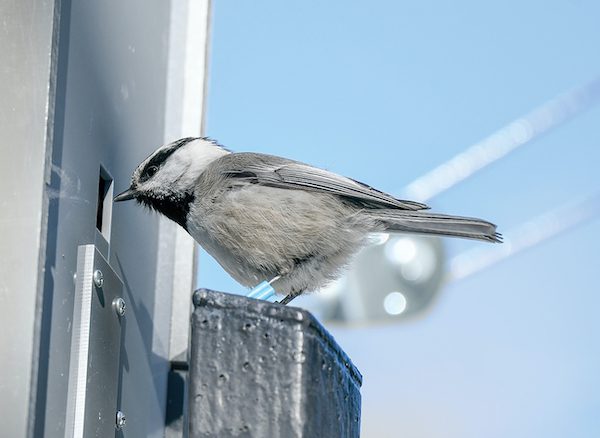
A chickadee checks a feeder for food during an experiment, photo by Vladimir Pravosudov
In this case, a good memory serves more like an anchor holding you down and keeping you from being flexible and efficiently figuring out a better solution.
When it comes to chickadees, birds living at higher elevations tend to have a better memory—which is necessary because they’re storing more food due to the colder and harsher conditions. The tradeoff, however, is less flexibility in solving novel problems.
Pravosudov worked on an experiment some years back creating clusters of chickadee feeders arranged in patterns, with individual feeders providing food on different days. If there were six feeders, for example, the first in the line would give food one day, then the fourth the next day, then back to the first, then fourth once again. Chickadees at lower elevations, such as those in the Truckee area, quickly figured out the pattern, or what the researchers called “the rule.” In other words, they knew when they woke up each morning whether the first or fourth feeder would be dispensing seeds, and they would go directly to whichever was live that day. A setup with a circle of feeders that opened in a clockwise or counter-clockwise pattern revealed similar results.
Birds that spend their lives at the peaks of the chilly mountains couldn’t figure out the rules as quickly, because they were relying more on their memory. Their immense capacity for recall hampered them from catching on and thinking ahead. In essence, they were living in the past.
“Memory by itself doesn’t make an individual intelligent,” Pravosudov says, admitting, however, that “intelligence is a very ‘squishy’ issue.”
By that he means the definition is hard to pin down. While memory isn’t intelligence, it’s not not part of the cognition puzzle. He’s fascinated by chickadees, but when pressed, he explains that they’re specialists devoted to pine seeds. He lists the animals he thinks are the smartest in the Tahoe area, classifying most of them as “generalists,” like humans. At the top of his list are ravens, which he puts above even bears.
“They are everywhere,” Pravosudov says, “watching everything.”
Raccoons are on his list (“super adjustable, super smart”), as well as coyotes and bears. Perhaps surprisingly, some more recent immigrants to the area also make the Top 10: Norway rats, which learn how to navigate around traps and flourish in areas where humans congregate.
Dam Geniuses?
As a wildlife education coordinator, Lord understands that the subject of animal intelligence would give most people working in her field pause. She’s happy to cite black bears and bats as having a high capacity for memory, and she’ll talk at length about rainbow trout that return without fail to their original spawning grounds after years away, red foxes that interpret low-frequency sounds to find prey under dirt and snow and, of course, Pravosudov’s favorite chickadees.
Her smart animal of choice, however, is the beaver.
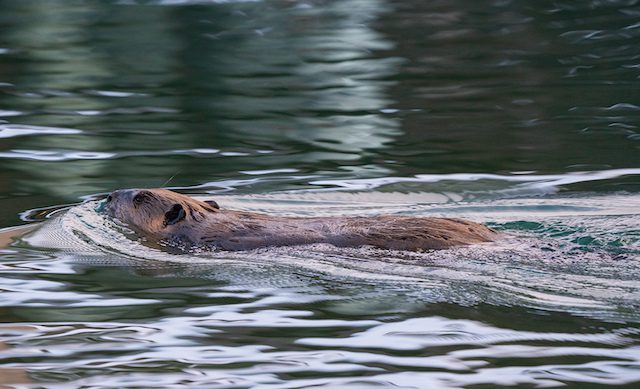
A beaver takes a leisurely swim in the Tahoe Keys, photo by David Braun
“We call them our ecosystem engineers around here,” Lord says. “They’re great at … transforming landscapes for great wetland habitat that lots of animals use.”
The dams they construct and the resulting pools that form can filter debris from waterways and even mitigate the effects of climate change.
“From personal experience,” Lord adds, “beavers are probably, in my opinion, some of the most impressive animals.”
In addition to Lord’s duties as a wildlife education coordinator, she also manages the Oxbow Nature Study Area, a 22-acre preserve in Reno that’s home to a family of busy beavers. She’s quite captivated by their ability to create habitat that’s rare to find in Nevada, the most arid state. While explaining her fascination, she specifically notes their incredible memories, reinforcing the apparently common correlation humans make between recall and intelligence. (Consider: Is someone who cleans up on trivia night at the bar or sweeps all the categories on Jeopardy a smart person? Or do they just remember a lot of stuff?)
Either way, Lord believes having the beavers around is a great thing. To keep the animals busy—and prevent structural damage to some decks in the preserve—crews will sometimes remove the dams.
“They pretty much put them up within 24 hours again,” Lord says.
Beyond her beloved beavers, she also lists the intelligent qualities of bats, such as the colony of free-tailed bats that roosts under the McCarran Bridge in Sparks: They have complex social systems, they take on young in need of parenting in emergency situations and they use echolocation to get around and find food. Of course, she also includes bears and coyotes—the latter of which, in particular, have found ways to thrive in relation to urbanization.
“The size of their habitat actually increases with human population growth,” she explains, “because they have found humans to be such a good resource for food.”
“Not eating humans!” she adds hastily. “But our trash!”
The Curse of the Brain
“Let’s say you’re a western tanager or whatever …”
Will Richardson, executive director of the Tahoe Institute for Natural Science, is rolling on the subject of animal intelligence—or, rather, what set of behaviors, adaptations and activities might look like “smarts” or cleverness from a human perspective.
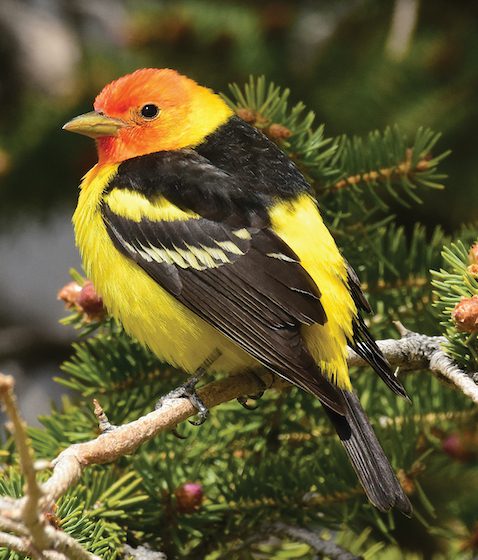
Western tanagers in the Tahoe area have been known to migrate to Panama, photo by Tom Koerner, courtesy U.S. Fish and Wildlife Service
If you’re a little bird with a taste for ants and mulberries, for example, knowing when to ditch the Tahoe area for someplace warmer when the weather takes a turn and blankets those bugs and berries under snow can seem like some big-brain thinking.
If we’re really broadening the definition of intelligence, Richardson muses, “Navigation in general is pretty wild.”
He explains how songbirds use celestial cues in their migrations, essentially building a map based on the night sky and relying on the right trajectory abstracted from the stars to get them to Central America.
So again, let’s say you’re a western tanager—about an ounce of bird covered in yellow and orange feathers vibrant enough to make a sunset blush—and you hatch in late spring.
“You hang out with your parents for a little while,” Richardson says, “and then it’s time to migrate. Where are you going? You’ve never been to Panama!”
The drive—and ability—to fly about 4,000 miles one-way to enjoy endless summer-type sunshine is certainly impressive, but is it due to intelligence? Most scientists put migration in the category of innate behavior, meaning it’s not even learned from watching other birds wing it south. Instead, it’s just something they’re born with.
Of course, they have to figure out timing for the return trip as well, which presents its own conundrum.
“Say you’re a male and want to come back to Tahoe because this is where it’s happening,” Richardson continues. “You want to get here early so you can get good territory. But too early? It’s winter and a total mess. Winters are highly variable, and tanagers don’t get the Weather Channel down in Panama.”
It comes down to patterns, Richardson says, and figuring out those patterns over generations, then adjusting and adapting as conditions change. At some point, does intelligence creep in?
Like virtually everyone interviewed for this story, Richardson hesitates a bit when presented with the subject of “animal intelligence.”
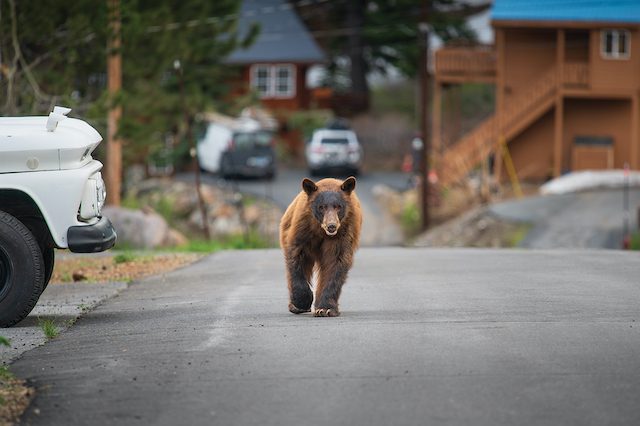
A bear waltzes down Rhineland Avenue in Tahoe Donner, photo by Megan Delehanty
“There are many different forms of intelligence,” he says, noting there’s a difference between cognition or problem-solving and simply having your behavior shaped by evolutionary processes that develop over huge time spans as animals simply figure out what works best to keep them alive.
Consider barn swallows that learn to flutter in ways that open automatic doors at big-box stores, or Steller’s jays that pick up on the fact that picnic tables, benches and trash cans tend to be places where leftover human food can be found in abundance. Are they being smart? Or do they just remember enough key variables that help them to easily find food? Then there are the coyotes that have to navigate life among cars.
“If you drive around Tahoe enough, you’re going to see coyotes trying to cross the road, and you may see them looking both ways and timing their crossing,” Richardson says. “I’ve never really thought much about that. Coyotes are smart, right?”
Peter Tira, information officer for the California Department of Fish and Wildlife Northern and North Central regions, declined an interview for this story, but did offer this quote: “There are no dumb animals, because dumb animals die.”
In other words, if you’re not smart enough to find food or avoid getting clipped by a Prius, you’re not going to pass on your genes. Even this idea, however, can be nitpicked.
Pravosudov points out that a flatworm isn’t intelligent, but does really well at what it needs to do to survive.
“Animals are just very well adapted to their environment,” he says. “Intelligence is in the eyes of the beholder.”
Ryan Miller is a Sacramento-area writer and editor. Follow him on Instagram or X, @jesteram.




No Comments